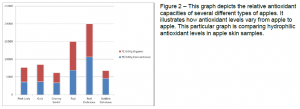Kylie Measom and Dr. Kim O’Neill, Department of Microbiology and Molecular Biology
They say “an apple a day keeps the doctor away.” Apples are laden with antioxidants which have been shown to prevent against cancer and other illnesses.1 Antioxidants are molecules that prevent cancer by collecting excess free radicals in the body. Free radicals are highly reactive molecules. They may interfere with DNA and other biomolecules leading to DNA damage and mutations. Antioxidants prevent this by scavenging for free radicals before they can interact with other important biomolecules.2 Apples, particularly the skins, have high phenolic content. Phenols are antioxidants that protect against oxidative damage caused by free radicals.3 Different types of apples and different parts of the apples contain various levels of phenolic content.4 While previous studies had measured antioxidant capacities of various types of apples and apple parts, there were more questions to be answered. For example, there had been a lot of debate about whether or not organic foods are healthier. My project studied the difference in antioxidant levels between several types of organic apples versus conventionally-grown apples of the same types. Additionally, I studied the content of different kinds of antioxidants within apples. There are lipid-soluble and water-soluble antioxidants, and both are necessary to protect against free radical damage in different parts of the body.5 Apple samples were tested using the Oxygen Radical Absorbance Capacity (ORAC) assay, according to published methods, with a Fluo-star Optima microplate reader.
No significant difference was observed between organic apples and conventionally-grown apples as regards antioxidant capacity, according to the ORAC Assay. The most significant differences in antioxidant capacity were found between skin samples and flesh samples. Apple skins contain a vast majority of the antioxidants present in apples and are therefore important to consume. With regards to skins, all types of apples showed significantly different levels of antioxidant capacity except for the following pairs: fuji/gala, pink lady/granny smith, pink lady/golden delicious, and granny smith/golden delicious. With flesh samples, all types showed significantly different antioxidant activity except for the pairs: fuji/granny smith, granny smith/gala, gala/red delicious, gala/golden delicious, gala/pink lady, red delicious/golden delicious, red delicious/pink lady, and golden delicious/pink lady. Some flesh samples were tested for lipophilic antioxidant capacity and average values were shown to be much lower than flesh samples tested for hydrophilic antioxidant capacity. Further studies should test more flesh samples as well as skin samples to determine the capacity of lipophilic antioxidant activity in apples.
I encountered several problems along the way as I went about the research project. For example, I had others helping me with the project and could not seem to get consistent results. The deadline for a conference I was hoping to present at was approaching, yet I did not have solid results to report. To help solve the problem, one of my fellow lab-mates created a very clear and specific protocol for the ORAC assay so that results would be consistent regardless of who was performing the assay. I ended up having to throw out quite a bit of old data and re-do many tests, but in the end I was left with data that I felt confident in. I was still able to submit my project to present at the undergraduate section of the annual meeting for the American Association for Cancer Research (AACR). The meeting took place in Chicago from March 30-April 4, 2012. This was a wonderful opportunity not only to present and be questioned on my own research, but also to hear from world-renowned scientists and discuss the latest research on cancer prevention.


